[ Tablet users, try the "web" version by clicking on "web" at the bottom of this page for a better, user-friendly format. ]
Rabbits are masters at disguising sickness. They are so good at it, that by the time we notice something amiss, it has usually already progressed to the point of requiring immediate action.
So what should a rabbit owner look out for? Rather than listing what conditions are common to house rabbits, we’ll list the symptoms or warning signs for which one should keep an eye out.
This page is not comprehensive by any means. It lists some common ailments seen in pet rabbits and is merely a guide for recognizing when your rabbit’s health may be compromised. This information is not intended to replace the need for a rabbit savvy vet. In fact, it is highly recommended that one find a rabbit savvy vet well before the need for one may arise. Don’t wait for an emergency and then waste precious time trying to locate a vet. Local rabbit rescues and rabbit forums are a good way to get references for rabbit savvy veterinarians.
So what should a rabbit owner look out for? Rather than listing what conditions are common to house rabbits, we’ll list the symptoms or warning signs for which one should keep an eye out.
This page is not comprehensive by any means. It lists some common ailments seen in pet rabbits and is merely a guide for recognizing when your rabbit’s health may be compromised. This information is not intended to replace the need for a rabbit savvy vet. In fact, it is highly recommended that one find a rabbit savvy vet well before the need for one may arise. Don’t wait for an emergency and then waste precious time trying to locate a vet. Local rabbit rescues and rabbit forums are a good way to get references for rabbit savvy veterinarians.
Basic list of warning signs. Never 'wait it out' in hopes the issue will resolve itself.
See further below for what to do.
See further below for what to do.
Change in output (poos):
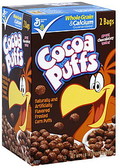
Any change in size, quantity or consistency of your rabbit’s poo is a certain sign to be on the alert. Rabbit poo should be round, dry, odor-free and about the size of cocoa puffs cereal. They poo often and it’s important to know what amount is normal for your bunny.
Possible condition: GI stress or GI stasis
If a rabbit suddenly has a change in poos, this is usually an indication of stress of the gastro-intestinal (GI) tract. A change in diet, a lack or shortage of hay, too much sugar (treats) or stress can all contribute to its onset. If poos are malformed, smaller than usual, or lesser in quantity, check to see how he is eating. Hay will be the best way to get things back to normal. If he is refusing food, see that section below.
If you notice normal size poos strung together like a ‘string of pearls,’ it is likely your bunny is in the midst of a shed. The poos are strung together because of the excess of fur ingested during shedding. In this case, be sure bunny is getting plenty of hay, water, and wet greens. Do some extra grooming as well to reduce the amount of loose fur. The presence of the 'strings of pearls' is nothing to be alarmed about – just an indication to take the precautionary measures mentioned.
If he has completely stopped producing poos, then he is in GI stasis (where the GI tract has stopped). This would be a 4-alarm emergency and he will need to see a vet immediately.
Possible condition: GI stress or GI stasis
If a rabbit suddenly has a change in poos, this is usually an indication of stress of the gastro-intestinal (GI) tract. A change in diet, a lack or shortage of hay, too much sugar (treats) or stress can all contribute to its onset. If poos are malformed, smaller than usual, or lesser in quantity, check to see how he is eating. Hay will be the best way to get things back to normal. If he is refusing food, see that section below.
If you notice normal size poos strung together like a ‘string of pearls,’ it is likely your bunny is in the midst of a shed. The poos are strung together because of the excess of fur ingested during shedding. In this case, be sure bunny is getting plenty of hay, water, and wet greens. Do some extra grooming as well to reduce the amount of loose fur. The presence of the 'strings of pearls' is nothing to be alarmed about – just an indication to take the precautionary measures mentioned.
If he has completely stopped producing poos, then he is in GI stasis (where the GI tract has stopped). This would be a 4-alarm emergency and he will need to see a vet immediately.
Poopy butt:

If a rabbit has mushy poo matted to his bottom, changes must be made since this is not normal. In some cases, it may be from filthy living conditions. Usually it is related to bunny’s diet. As explained in the diet section of this site, hay is the most important part of a rabbit’s diet. It should make up the bulk of his daily diet. A rabbit with a poopy bum is usually found to be eating too little (or no) hay, or had recently been fed something new or too much of something.
A rabbit with a poopy butt needs to be cleaned up safely and then steps need be taken to prevent a repeat of the condition. Some rabbits have more sensitive digestion that make them prone to this condition. By carefully monitoring a healthy diet and limiting the offending source (perhaps certain fruits/treats or certain greens or perhaps pellets) this condition can be prevented.
Possible conditions: flystrike, poopy bum
To clean a messy bum, place just his bum in a shallow tub of warm water-- just an inch of water will do. Do not ever immerse your rabbit in water. Do not ever bathe your rabbit. Wear latex gloves and gently work the mats loose. Scissors are not recommended to cut mats off since this risks injuring the very thin skin. Dry his bum thoroughly when done.
Flystrike refers to flies laying their eggs in the matted poo of a bunny suffering from poopy butt. The eggs hatch and the hatched eggs (maggots) begin to consume the rabbit from the inside out. If maggots are visible in bunny’s litterbox or on his back end, get him to a vet for prompt cleaning and treatment. Flystrike is far less common with indoor rabbits. Just be wary of any indoor flies.
A rabbit with a poopy butt needs to be cleaned up safely and then steps need be taken to prevent a repeat of the condition. Some rabbits have more sensitive digestion that make them prone to this condition. By carefully monitoring a healthy diet and limiting the offending source (perhaps certain fruits/treats or certain greens or perhaps pellets) this condition can be prevented.
Possible conditions: flystrike, poopy bum
To clean a messy bum, place just his bum in a shallow tub of warm water-- just an inch of water will do. Do not ever immerse your rabbit in water. Do not ever bathe your rabbit. Wear latex gloves and gently work the mats loose. Scissors are not recommended to cut mats off since this risks injuring the very thin skin. Dry his bum thoroughly when done.
Flystrike refers to flies laying their eggs in the matted poo of a bunny suffering from poopy butt. The eggs hatch and the hatched eggs (maggots) begin to consume the rabbit from the inside out. If maggots are visible in bunny’s litterbox or on his back end, get him to a vet for prompt cleaning and treatment. Flystrike is far less common with indoor rabbits. Just be wary of any indoor flies.
Refusing food:
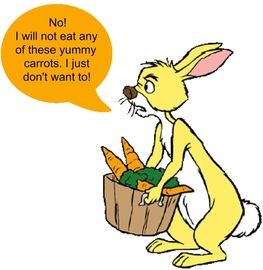
If a rabbit suddenly refuses his usual foods, something is wrong. It is not a sudden case of pickiness. As soon as a rabbit refuses a food that he usually eats, check his poo output. (refer to that section above) If he refuses hay and refuses pellets then test him with a favored green. If he still refuses, check his posture. He may sit in a “football” crouch indicating discomfort from gas. Or, in milder cases, he may stretch out in a place that he usually does not lounge.
Possible conditions: GI stress or GI stasis, dental problem
Syringe feeding simethicone (baby gas drops) can often give bunny enough relief to get him eating again. Feed the baby gas drops every half hour for a couple hours. Then every hour for a few hours. If he begins eating, then he’s on the road to recovery and simethicone can be stopped.
A rabbit that refuses to eat for 12 hours should be seen by a rabbit savvy vet. The GI tract needs to remain active. If he stops eating for long then GI stasis is imminent.
If bunny has been in the midst of a shed, be sure he eats plenty of hay. Ingested fur can cause a blockage, but hay is the best way to help everything pass through the digestive tract.
A rabbit that is suddenly picky only about certain foods may be having trouble eating those foods due to a problem with his teeth. He may eagerly go to his food, and then hesitate or refuse to eat it. See ‘drooling’ for more.
Possible conditions: GI stress or GI stasis, dental problem
Syringe feeding simethicone (baby gas drops) can often give bunny enough relief to get him eating again. Feed the baby gas drops every half hour for a couple hours. Then every hour for a few hours. If he begins eating, then he’s on the road to recovery and simethicone can be stopped.
A rabbit that refuses to eat for 12 hours should be seen by a rabbit savvy vet. The GI tract needs to remain active. If he stops eating for long then GI stasis is imminent.
If bunny has been in the midst of a shed, be sure he eats plenty of hay. Ingested fur can cause a blockage, but hay is the best way to help everything pass through the digestive tract.
A rabbit that is suddenly picky only about certain foods may be having trouble eating those foods due to a problem with his teeth. He may eagerly go to his food, and then hesitate or refuse to eat it. See ‘drooling’ for more.
Sneezing:
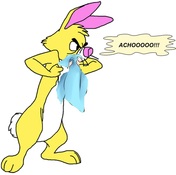
A sneezing rabbit may be simply reacting to a tickle in his nose caused by fur, dust, or hay. However, if the sneezing is accompanied by a runny nose, something else may be going on. If the discharge is clear (like water), then the sneezing and runny nose is most likely not the result of an infection. Possible sources could be dusty bedding, dusty hay, or a certain type of hay. Try eliminating possible sources to figure it out. Allergies in rabbits are quite rare. Persistent sneezing and watery discharge may be a precursor to a milky discharge and infection.
Possible conditions: respiratory infection (aka: snuffles), allergies
If the discharge is not clear but milky, yellowed or colored, that is a sure sign of an infection. Such an infection can only get better with the use of rabbit-safe antibiotics as prescribed by a vet. The sooner treatment can begin, the better the prognosis. Do not delay. This is NOT a “cold” that will run its course and go away on its own.
If treatment is delayed too long, the condition can become chronic requiring lifelong treatment. If this infection is not treated, it will progress and get worse. Eventually it may spread to other organs and eventually cause death.
Possible conditions: respiratory infection (aka: snuffles), allergies
If the discharge is not clear but milky, yellowed or colored, that is a sure sign of an infection. Such an infection can only get better with the use of rabbit-safe antibiotics as prescribed by a vet. The sooner treatment can begin, the better the prognosis. Do not delay. This is NOT a “cold” that will run its course and go away on its own.
If treatment is delayed too long, the condition can become chronic requiring lifelong treatment. If this infection is not treated, it will progress and get worse. Eventually it may spread to other organs and eventually cause death.
Runny eyes or runny nose:
Check bunny’s paws for signs of runny nose or eyes. Discharge may be present on bunny’s forepaws from self-grooming. If a runny nose is accompanied by sneezing, check the section on ‘sneezing.’ If runny eyes are accompanied by symptoms described in ‘sneezing,’ then the snuffles infection may have spread to the eyes causing conjunctivitis.
Possible conditions: respiratory infection, dental disorder, conjunctivitis
Runny eyes may result from a bout with snuffles. It may also occur independently. In either case, treatment by a veterinarian will be required. Since conjunctivitis can be caused by the environment (hay in eye, for example), a viral infection, a bacterial infection, or a dental disorder, a rabbit-savvy vet can help determine the cause and the corresponding treatment.
A damp, warm cloth can be used to wipe the eyes until a vet can be seen.
Possible conditions: respiratory infection, dental disorder, conjunctivitis
Runny eyes may result from a bout with snuffles. It may also occur independently. In either case, treatment by a veterinarian will be required. Since conjunctivitis can be caused by the environment (hay in eye, for example), a viral infection, a bacterial infection, or a dental disorder, a rabbit-savvy vet can help determine the cause and the corresponding treatment.
A damp, warm cloth can be used to wipe the eyes until a vet can be seen.
Drooling, or matted fur around face:
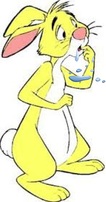
A rabbit that is losing fur around his face from persistent drooling may be suffering from a dental disorder. Wet fur on his face and forelimbs are other indicators. He may drop food, lose weight, drool, eat less, groom less, become picky about certain foods that he used to eat, or have bad breath. He may also have runny eyes as described above.
Possible conditions: dental disorders including malocclusion, abscesses, fractures, spurs
Dental disease can be hereditary or from injury or from age. Dental problems can prevent bunny from eating certain foods or from eating altogether. Such issues can also be quite painful for bunny. Again, a rabbit savvy vet can determine what is wrong and how to treat it.
Flaky skin or dandruff:
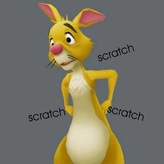
A rabbit with dry or flaky skin may have any one of a number of parasites. There are various mites that can infect rabbits. Small scabs or black dots inside a bunny's ears is usually an indication of ear mites (as opposed to fur mites). Flakes that look like dandruff is a sign of fur mites. Mites, fleas and ticks can be treated in rabbits with the application of Revolution (active ingredient: selamectin). Do NOT use Frontline (active ingredient: fipronil) which has been known to kill rabbits. If in doubt about what or how much to use, contact a rabbit savvy veterinarian.
Possible conditions: mites, fleas, ticks, or other parasitic infestation, mange
A rabbit with dry or flaky skin may have any one of a number of parasites. There are various mites that can infect rabbits. Small scabs or black dots inside a bunny's ears is usually an indication of ear mites (as opposed to fur mites). Flakes that look like dandruff is a sign of fur mites. Mites, fleas and ticks can be treated in rabbits with the application of Revolution (active ingredient: selamectin). Do NOT use Frontline (active ingredient: fipronil) which has been known to kill rabbits. If in doubt about what or how much to use, contact a rabbit savvy veterinarian.
Possible conditions: mites, fleas, ticks, or other parasitic infestation, mange
Urinating outside the litter box:
A rabbit that is fully litter trained and suddenly begins urinating outside his litter box may have a urinary tract infection. First, however, rule out other possible causes. A change in environment, the addition of a new household pet, a change in his routine, a too-dirty litter box, a change in the litter box set up, the onset of hormones – any of these can lead to some peeing rebellion.
Possible condition: urinary tract infection
If he is just piddling here and there, it is more likely an indication of an infection. In this case, schedule a vet visit.
Possible condition: urinary tract infection
If he is just piddling here and there, it is more likely an indication of an infection. In this case, schedule a vet visit.
Exposed or raw skin on bottom of paws:
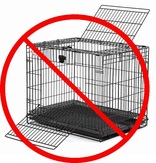 Avoid wire flooring.
Avoid wire flooring.
Unlike dogs or cats, rabbits do not have pads on the bottom of their paws—just fur. If the fur has been rubbed off, the delicate skin underneath can become sore and raw. Infection can also set in.
Possible condition: sore hocks
Sore hocks is commonly attributed to rabbits that live on wired flooring. Overweight rabbits are also more prone. However, rabbits that live exclusively on carpet have also been known to get sorehocks (though this is far more rare). Having a variety of flooring options is a good preventative. Look for some flooring to mimic the softness of earth or grass.
Any open sores on the feet require a visit to the vet for proper treatment.
Possible condition: sore hocks
Sore hocks is commonly attributed to rabbits that live on wired flooring. Overweight rabbits are also more prone. However, rabbits that live exclusively on carpet have also been known to get sorehocks (though this is far more rare). Having a variety of flooring options is a good preventative. Look for some flooring to mimic the softness of earth or grass.
Any open sores on the feet require a visit to the vet for proper treatment.
A Note About Vaccines for Rabbits
This website is based in the United States. Pet rabbits in the US do not get vaccines*. Pet rabbits in the United Kingdom or Australia, however, require vaccines. I believe vaccine against myxomitosis and RHD is needed in the UK, and vaccine against calcivirus (RHD) is needed in Australia. However, further research regarding vaccines is strongly recommended if you live outside the United States.
*There has been a recent outbreak of RHDV2 across the Southwest, Pacific Northwest, and New York. In some of these areas, vets may seek special permission to import the vaccine to the US. For further detail, click HERE.
*There has been a recent outbreak of RHDV2 across the Southwest, Pacific Northwest, and New York. In some of these areas, vets may seek special permission to import the vaccine to the US. For further detail, click HERE.

